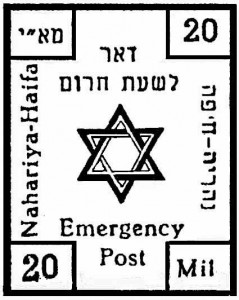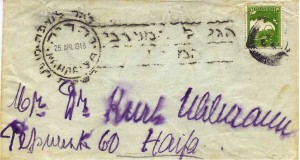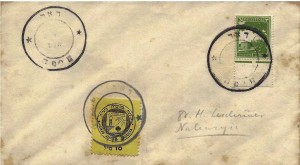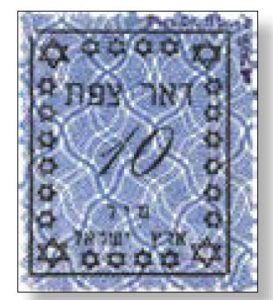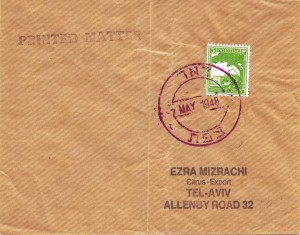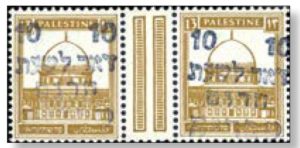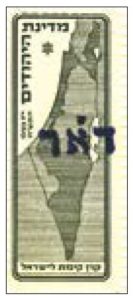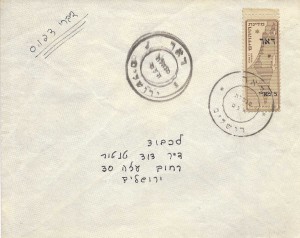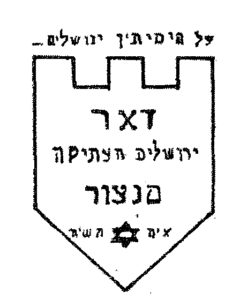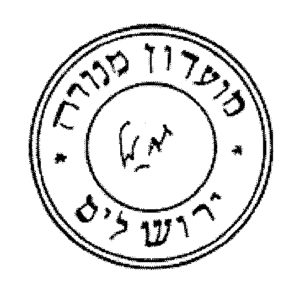INTERIM PERIOD II
PHILATELIC
March 22, 1948 – August 8, 1948
OFFICIAL
May 6, 1948 – May 15, 1948
LOCAL ISSUES
GENERAL
“With the exception of the provisional issues of the City of Jerusalem all local issues of the Interim Period were initially met with great caution and suspicion. There was little publicity about their existence and falsification, misrepresentation, and misuse of the postal services during this period was quite common. . . . With the exception of the provisional issues of the City of Jerusalem all local issues of the Interim Period were initially met with great caution and suspicion. There was little publicity about their existence and falsification, misrepresentation, and misuse of the postal services during this period was quite common.”
“All local issues were emergency measures which were designed to ease a temporary local problem.
. . . . . The primary function of the local issues was to allow the inhabitants of these cities or towns to be able to maintain a means of communication, and this frequently only within the city limits.”
Forsher, p. 53.
Go to “BACKGROUND” at bottom for more information.
T
Nahariya Emergency Mail
(Go to “BACKGROUND” at Bottom for more information)
Between March 22, 1948 and April 25, 1948, the Nahariya Emergency Boat Service was strictly an emergency measure and as such it was directed by the Mishmar Ha’am. During this period, there were no special postage stamps issued, but a number of special cancellations were provided . . .
Forsher, p. 61.
” . . . on March 22, 1948, the first known and identified batch of letters from Nahariya reached the city of Haifa.”
“Relatively late, the Nahariya Municipal Council authorized the printing of three different postage stamps for the prepayment of the Emergency Mail Boat forwarding fee. This fee was collected over and above the regular postage required for the delivery of mail. The first stamps were placed on sale on April 25, 1948. The rate schedule was double that of the regular postage rates of the outgoing British Mandate postal services. Thus, the special rates were: 10 mils for postcards; 20 mils for regular letters; and 50 mils for registered letters.
Forsher, p. 55.
STAMPS
Emergency Post issue and Emergency Mail issue.
The Nahariya Municipal Council authorized the printing of postage stamps.
(Below is Emergency Post Issue)
COVERS
Example
Cancellations
“a number of special cancellations were provided” (Forsher, p. 61)
(Below is Nahariya to Haifa)
(Below is Haifa to Nahariya)
(with City Label for Postage Due)
Rishon LeZion Armored Car Mail
(Go to “BACKGROUND” at Bottom for more information)
“During the early part of March, 1948 a situation developed there which can be compared to the one of Nahariya.”
” . . . he Council resolved to make use of an armoured car . . . .”
” . . . agreement was reached to organize and operate a postal service between_ Rishon leZion, Nachlat Jehuda, and Tel Aviv, making use of the armoured car.
“The 40 mils stamp thus authorized . . . .”
Forsher, p. 65.
“Three special postmarks were provided for the cancellation of the Rishon leZion Armoured Car Express Mail stamp.
Forsher, p. 71.
STAMPS
“The 40 mils stamp thus authorized was designed by Eva Samuel, a Rishon leZion artist, and shows an armoured car, guarded by an armed soldier. It has the inscription ERETZ ISRAEL – RISHON LEZION. BY ARMOURED CAR – 1948. 40 (mils).”
Forsher, p. 65.
COVERS
Special Postmarks
:Three special postmarks were provided for the cancellation of the Rishon leZion Armoured Car Express Mail stamp.”
Forsher, p. 71.
Zefat (Safed) Mail
(Go to “BACKGROUND” at Bottom for more information)
“Since, with the parting of the British the only post office accessible to the Jewish sector of Zefat had been closed, there were no postage stamps or postal cancelers available.”
“Meanwhile, a number of special stamps were prepared.”
Forsher, p. 74.
There were two Provisional Postmarks.
- Type I. In use May 4 and 5, 1948.
- Type II. In use May 6 to May 19, (noon).
Forsher, p. 78
STAMPS
COVERS
Example
Cover
Zefat (Safed) Type II Postmark
Affulah, Nahalal & Tiberias Mail
(Go to “BACKGROUND” at Bottom for more information)
“The Hebrew overprinted British Mandate stamps of these three towns belong undoubtedly to the most controversial Interim material of the Local Issues. Only meager evidence exists to permit their acceptance as authentic postage stamps.”
“As far as the towns of Affulah or Nahalal are concerned, it is the considered opinion of the writer that they simply duplicated the Tiberias setup but had neither a reason nor a justification to do so. A real emergency existed only in the City of Tiberias, of which an account is presented. As far as the towns of Affulah or Nahalal are concerned, it is the considered opinion of the writer that they simply duplicated the Tiberias setup but had neither a reason nor a justification to do so. ”
Forsher, p. 79.
Stamps
(Tiberias)
Jerusalem Mail
(Go to “BACKGROUND” at Bottom for more information)
“The provisional stamps of Jerusalem were released under the conditions of a siege.
The most important communication link between Jerusalem and the rest of Palestine was the Jerusalem Post Road . . .
There is also a single track railroad line, but the operation of trains had been discontinued much earlier by the British.
There was finally a precarious airline link maintained by Piper Cub planes which landed on a tiny airstrip West of Rehaviah.
On April 13, 1948, the British Mandate Postal Administration . . . he offices were actually closed by April 25. . . .
Between April 25 and May 9, there was no postal services in any part of Jerusalem . . .
It was established that no supply of Mandate stamps was left. It was also established that no large quantities of Jewish National Fund labels were on hand.”
Forsher, p. 83.
Three branch offices were opened on May 9, 1948. These were the stations of Rehaviah, Mahne Yehuda and Mea Shearim. . . . The three post offices listed above were the only ones in operation in Jerusalem until May 21 when the Main Post Office of Jerusalem was re-opened.”
Forsher, p. 84.
Stamps
Example
There were three issues of the provisional Jerusalem stamps. (Forsher, pp. 83 -85)
COVERS
Jerusalem Provisional Stamp
and
Minhelet Ha’am Postmark
COVERS
Postmark
(Jerusalem “Old City”)
COVERS
Postmark
(Jerusalem Menorah Club)
BACKGROUND
General.
“With the exception of the provisional issues of the City of Jerusalem all local issues of the Interim Period were initially met with great caution and suspicion.
- There was little publicity about their existence and falsification, misrepresentation, and misuse of the postal services during this period was quite common.
- The items which are listed in this section of the handbook were found to have been “officially authorized”.
However, it should be kept in mind that the judgement as to what can be considered as “officially recognized” for the prepayment of mail under emergency condition poses a problem as this “authority” varied from place to place. - Even after twenty years of research, not all problems have been resolved, and not all items are fully accounted for. “
All local issues were emergency measures which were designed to ease a temporary local problem. In all cases where special local stamps were printed and issued, the stamps were crudely designed and produced. Most are lacking in truly artistic design. The primary function of the local issues was to allow the inhabitants of these cities or towns to be able to maintain a means of communication, and this frequently only within the city limits. Evidently it was easier and safer to post a letter to a friend or family in the house mail box than to go and visit them even if they lived only a block away, but separated by crossfire of the enemy; a situation frequently experienced in Jerusalem.
All local stamps were promptly withdrawn, and remaining stocks were destroyed soon after the local emergency ceased to exist.
- This poses a difficulty in respect to the evaluation, since, in most cases, it is known approximately how many of the stamps were printed, but it is rarely known how many of the stamps were destroyed. “
Forsher, p.53.
Nahariya.
Emergency Post issue and Emergency Mail issue.
“Nahariya Municipal Council authorized the printing of three different postage stamps for the prepayment of the Emergency Mail Boat forwarding fee. This fee was collected over and above the regular postage required for the delivery of mail. The first stamps were placed on sale on April 25, 1948. The rate schedule was double that of the regular postage rates of the outgoing British Mandate postal services. Thus, the special rates were: 10 mils for postcards; 20 mils for regular letters; and 50 mils for registered letters.
Stamps.
” . . . the printing of three different postage stamps for the prepayment of the Emergency Mail Boat forwarding fee.
- This fee was collected over and above the regular postage required for the delivery of mail.
- The first stamps were placed on sale on April 25, 1948.
- The first issue of the postage stamps is known as the Emergency POST issue, reflecting a rather poor English translation of the Hebrew caption. Numerous printing varieties are known to exist. There are also some plate varieties.
- On May 16, 1948, a slightly modified design of the three stamps was placed on sale together
with a souvenir sheet which shows all three stamps (second issue) printed on cream colored paper.
“On May 16, 1948, a slightly modified design of the three stamps was placed on sale together with a souvenir sheet which shows all three stamps (second issue) printed on cream colored paper.
- This issue is known as the Emergency MAIL issue, reflecting an improvement in the English translation.”
- The Emergency Mail stamps were in use for only 5 days as the boat service was evidently suspended by May 21, when the normal postal delivery by van was resumed.
“The rate schedule was double that of the regular postage rates of the outgoing British Mandate postal services. Thus, the special rates were: 10 mils for postcards; 20 mils for regular letters; and 50 mils for registered letters. ”
Forsher, pp. 55 -56.
Postage Due.
During the month of April, the Mishmar Ha’am of Nahariya also authorized the collection of a fee for the mail taken by boat from Haifa to the isolated city. For accounting purposes, a city label (tax stamp) was affixed to these letters to serve as a postage due stamp. It is known on letters in two colors: yellow, and red. Letters with these tax labels are quite scarce.
Forsher, pp. 55- 56.
Note.
On April 25, 1948, the Municipality of Nahariya took over the operation of the mail service. At this point in time, the postage stamps, postage due stamps and a rubber cancellation device known as Type V were introduced.
Forsher, p. 61.
Cancellations
“a number of special cancellations were provided known as Types I through Types IV. These cancellations were made by a stencil, inserted_ in a small duplicating machine.
On April 25, 1948, the Municipality of Nahariya took over the operation of the mail service. At this point in time, the postage stamps, postage due stamps and a rubber cancellation device known as Type V were introduced.”
Forsher, p. 61.
Rishon LeZion Armored Car Mail.
“During the early part of March, 1948 a situation developed there which can be compared to the one of Nahariya. All communications, and in particular the mail service with Tel Aviv, had become most precarious. In fact, the British Mandate mail delivery service had been reduced to twice a week only, and even this token service was threatened with suspension.”
“. . . the Council resolved to make use of an armoured car in spite of the British hesitation to approve its use, so as to maintain contact with Tel Aviv. This fact furnished the first thought toward the establishment of a special express mail service.”
” . . . on March 28,m 1948 . . . agreement was reached to organize and operate a postal service between_ Rishon leZion, Nachlat Jehuda, and Tel Aviv, making use of the armoured car. In order not to violate the provisions of the British Mandate Government which were still in effect, the Council appointed a special committee which was charged to organize this service and operate it. . . . It was this committee which agreed to issue a special provisional stamp, and operate the service daily except for the Sabbath.”
“The 40 mils stamp thus authorized . . . .”
Forsher, p. 65.
Stamps.
“The 40 mils stamp thus authorized was designed by Eva Samuel, a Rishon leZion artist, and shows an armoured car, guarded by an armed soldier. It has the inscription ERETZ ISRAEL – RISHON LEZION. BY ARMOURED CAR – 1948. 40 (mils). This stamp was printed in sheets of 10, consisting of two horizontal rows of five stamps each. Only one single plate was made and used. The stamps were printed at Mercaz Press in Rishon leZion, on April 1 and 2, 1948. They were placed on sale on April 4 and they became valid on April 5, 1948.”
Forsher, p. 65.
Special Postmarks and Covers.
“Three special postmarks were provided for the cancellation of the Rishon leZion Armoured Car Express Mail stamp. The marks of Rishon leZion and Tel Aviv were used on both outgoing and incoming mail. On incoming mail, the postmark was commonly applied on the rear of the envelope. The postmark of Nachlat Jehuda was only used on outgoing mail. In some instances, mail from Tel Aviv to Nachlat Jehuda was marked in transit to Rishon leZion. In these cases, the Rishon leZion postmark is commonly found on the lower left front of an envelope. All postmarks are in black color. The cancelling devices were made of rubber. Those of Tel Aviv and Rishon leZion measure 34½ mm in diameter. The Nachlat Jehuda postmark is in a rectangular frame which measures 38 mm by 16mm.”
“Most common are cancellations from the period May 2nd to May 6th; and many of them are obviously courtesy cancellations.”
“There is little known about the number of letters carried by the service.”
Forsher,.p. 71.
Zefat (Safed) Mail.
“Since, with the parting of the British the only post office accessible to the Jewish sector ofZefat had been closed, there were no postage stamps or postal cancelers available. The staff officer, a Yehuda Gross, appointed Dov Geiger on April 21 Commissioner for the Postal Services of Zefat with instructions to prepare for an emergency postal service.”
It was not until June that the DOAR IVRI stamps and the State of Israel canceller replaced the provisional postal stamps and postmarks.”
Forsher, p. 75.
Stamps (Local Provisional and DOAR IVRI).
“Meanwhile, a number of special stamps were prepared. Yehuda Gross took an active part in the design and approval of these stamps.
. . . the final solution was found. The inner envelope paper decorative printing provided the wavy line background which is characteristic for these Zefat provisional stamps. Two settings for the printing of the stamps are known to exist, . . . . In all, 2200 stamps were printed during the period of siege. A very few of the trial envelopes, but none of the orange-on-white trial copies have survived.”
Forsher, p. 74
“Cancellation marks from Zefat showing the British Mandate postmarks with a date of this period are some of the rarest items of the transition period. All strikes were made on the new DOAR IVRI stamps of Israel.”
Forsher, p. 78.
Cancellations (Local Provisional, Minhelet Ha’am and British Mandate).
There were 2 cancellations: Type I and Type II.
“For the first two days of their use, the stamps were cancelled with a very crude temporary canceller, an elongated rectangular frame within which the date was inserted. On May 6th, the more commonly known circular postmark was introduced. . . .
Forsher, p. 74.
“Type I. In use May 4 and 5, 1948. The simple rectangular frame measures 53 mm by 10 mm. It was a cut made oflinoleum. The date was added by a European calendar date stamp. Since a postal stamp pad was not available, carmine-red ink was used for the cancellations. A majority of covers show a May 4, 1948 date. Very few (if any) covers with a May 5 date are known to exist.”
“Type II. In use May 6 to May 19, (noon). The single bridge, double circle mark shows the Hebrew words DOAR ZEF AT in the upper respectively lower part of the double circle ring. The outer circle measures 39 mm in diameter. The inner circle measures 26 mm in diameter. Again, the date was added by an European calendar date stamp. The color of the postmark is carmine-red.”
“Following May 19, 1948 the Minhelet Ha’am postmark which had arrived at Zefat at that late date was used, although at this date it had already been made obsolete in most of the other Jewish post offices. It has the unique distinction of showing also in the same carmine-red color as the two local provisional postmarks and it is the only Minhelet Ha’ am mark ( except for the green-blue Nahariya receiving mark) which comes in a color other than black or violet. Eventually, strikes were also made of most of the retired Minhelet Ha’am postmarks in black; hence, the Zefat provisional mark also exists in black, on philatelic covers.”
” . . . the retired British Mandate canceller . . . returned to the Zefat post office and was in use there from June 27 until July 6, 1948. Cancellation marks from Zefat showing the British Mandate postmarks with a date of this period are some of the rarest items of the transition period. All strikes were made on the new DOAR IVRI stamps of Israel.
The State oflsrael cancellation mark was first introduced on July 7, 1948.”
Forsher, p. 78
Affulah, Nahalal & Tiberias Mail.
“The Hebrew overprinted British Mandate stamps of these three towns belong undoubtedly to the most controversial Interim material of the Local Issues. Only meager evidence exists to permit their acceptance as authentic postage stamps. A real emergency existed only in the City of Tiberias, of which an account is presented. As far as the towns of Affulah or Nahalal are concerned, it is the considered opinion of the writer that they simply duplicated the Tiberias setup but had neither a reason nor a justification to do so.”
“Perhaps the provisional local stamps were used in the early days of May as a stop gap measure since the validated Jewish National Fund labels may not have arrived. However, one can find letters of a 9 May postdate (with a Hebrew date stamp) which do show the Minhelet Ha’am provisional stamps affixed to same; hence one must conclude that, if at all, the local provisional adhesives could have served a good purpose only up to May 9, 1948.”
Jerusalem Mail.
The most important communication link between Jerusalem and the rest of Palestine was the Jerusalem Post Road . . .
There is also a single track railroad line, but the operation of trains had been discontinued much earlier by the British.
There was finally a precarious airline link maintained by Piper Cub planes which landed on a tiny airstrip West ofRehaviah.
On April 13, 1948, the British Mandate Postal Administration published their final Circular #53, in which it announced the closing of the Jerusalem Main Post Office and of all substations, effective May 5, 1948. However, due to hostilities, the offices were actually closed by April 25.
Between April 25 and May 9, there was no postal services in any part of Jerusalem and letter boxes remained unemptied. Nor was there any mail delivery.
Forsher, p. 83.
It was established that no supply of Mandate stamps was left. It was also established that no large quantities of Jewish National Fund labels were on hand. However, it was discovered that Haoman Press, the printer of the
Forsher, p. 83.
(cont.) Partition Map stamps (see listing 120 T-x to 125 T-x), still had the plates used for the printing of these K.K.L. labels and some stock of same.
“Three branch offices were opened on May 9, 1948. These were the stations ofRehaviah, Mahne Yehuda and Mea Shearim.”
“The three post offices listed above were the only ones in operation in Jerusalem until May 21 when the Main Post Office of Jerusalem was re-opened.”
Forsher, p, 84.
After April 20, the road remained blocked and no communication with the rest of the country, except by air, was possible until June 18,
. . .
The first postal communication of the city under siege with the rest of the State of Israel was accomplished over this precarious road on June 18, 1948.
Forsher, p. 85.
Stamps.
“The provisional stamps of Jerusalem were released under the conditions of a siege. They were issued to satisfy the real and urgent need of a large city. They appear to be almost completely free of any philatelic manipulation. This enhances their value. Furthermore, their historic significance and their association with the hallowed name of the city which issued them makes these Local Issue stamps items of unusual importance.
It was established that no supply of Mandate stamps was left. It was also established that no large quantities of Jewish National Fund labels were on hand. However, it was discovered that Haoman Press, the printer of the
Forsher, p. 83
Partition Map stamps (see listing 120 T-x to 125 T-x), still had the plates used for the printing of these K.K.L. labels and some stock of same. Hence it was agreed to make use of both the stock and the plates. A new supply of the labels were ordered, and a black color typographed overprinting DOAR and VALUE below authorized to indicate the validity of these provisional stamps for the prepayment of letters.
n spite of the precautions, the first issue was sold out within hours. Meanwhile, a second printing of the same stamps was in progress at Haoman Press which was also instructed to do the overprinting. (The overprinting of the first issue had been done by Lipshitz Press to take some of the burden away from Haoman Press.) The 2nd issue was printed in sheets of 20 stamps. And since Haoman Press did the composition of the DOAR and VALUE overprinting plate independently from Lipshitz Press, a different arrangement was the result. The second issue appeared on sale in the afternoon of May 10, 1948, at two post offices.
Besides spacing of words, the difference between the first and second issues includes a change of paper colors. The 10 mils value of the first issue was printed on blue colored stock. Since it was impossible to locate another batch of this blue color paper, Haoman Press added some light blue color on the top of the sheets of white paper used for the printing of the stamps. Hence, the 10 mils stamps of the second issue is printed on blue background, but the backside of the stamp is white in contrast to the backside of the 10 mils of the first issue.”
Forsher, p. 84.
“Shortly before the arrival of the first DOAR IVRI stamps, a third batch of the 5 mils provisional stamp of Jerusalem was ordered. The setting of the overprinting on this K.K.L. label is the same as found on the second issue except that the top of the numeral 5 is slightly curved upward. This is therefore known as the third issue. These stamps were on sale for a few days only, and they have become rather scarce items.”
“However, the provisional stamps of Jerusalem continued to be valid for some time and their occasional use can be traced all through the month of July.”
“It is also known that the first supply of the DOAR IVRI stamps did not reach Jerusalem before June 20, and they were then put on sale.”
Forsher, p. 85
Postmarks.
The Jerusalem Postmarks.
- “Type I. The provisional Minhelet Ha’am postmark (as such it is not counted as a Local Issue provisional) appears with two variations on the Jerusalem scene. One of them shows the outer circle with a deformation. The other one . . . shows a pair of rosettes in lieu of the five-pointed stars. Both variations appear on Rehaviah cancellations” (Forsher, p. 90)
“The three post offices [editor’s note: Rehaviah, Mahne Yehuda and Mea Shearim] . . . were the only ones in operation in Jerusalem until May 21 when the Main Post Office of Jerusalem was re-opened. They made use of the Minhelet Ha’am cancellers which had been received (probably by the airlink) of Type “A” design. An additional Minhelet Ha’am canceller was ordered and in use between May 14 and May 18 which has rosettes in the place of the five pointed stars ” (Forsher, p. 84)
” . . . demands to reopen the Main Post Office of Jerusalem were honored and this office was back in operation by May 21. With the Minhelet Ha’am cancellers in short supply and no longer valid due to postal regulations, a need for a temporary solution for the supply of appropriate cancellation devices developed. Since engraved metal handstamps were not ready anywhere in Jerusalem and could not be made on short notice, some special instruments were made of rubber, so creating the peculiar bi-lingual provisional postmarks of Jerusalem. (Forsher, p. 85.)
- “Type II. Special postmark used on 16 May 1948 only, to commemorate the Proclamation of the State of Israel. The double ring circles measure 34 mm on the outside, and 25 mm on the inside. The upper half of the ring shows the Hebrew inscription DOAR JERUSHOLA YIM (Jerusalem Post). Within the inner circle appears the Hebrew caption MINHELET HA’AM, DOAR, Hei, Tav, Shin, CHet (People’s Administration, Post, 5708). This mark was used exclusively for the cancellation of the Jerusalem provisional stamps.” (Forsher, p. 90.)
- “Type III. The bi-lingual provisional postmark. This cancellation mark was used in the Main P.O. beginning with May 21, 1948. Two variations of the mark are known, obviously caused by two different hammers. On the perfect circle mark, two concentric circles appear, spaced about 2 mm. The outside diameter of the ring is about 41 mm. The Hebrew and English spelling of the name of the town are separated by a pair of stars. On the distorted mark, the stars arc missing. The type was in use until July 4, 1948.” (Forsher, p. 90.)
“The first day of use of the tri-lingual postmark of the State of Israel was only on July 4, 1948. At this time, a total of 11 cancellers were delivered to the four post offices in operation. The Main P.O. received Jerusalem 3, 7, 9, and 11; Rehaviah got Jerusalem 1, 2, 4, 6, and 12; Mahne Yehuda received Jerusalem 8; and Mea Shearim got Jerusalem 10. (Jerusalem 5 was kept in reserve.) These marks are found on many Jerusalem provisional stamps which were in use until the end of July.” (Forsher, p. 90)
“From July 4, 1948, regular State of Israel postmarks made their appearance. And it must be concluded that the provisional cancellation devices were withdrawn at this date. (Forsher, p. 85.)
Covers.
“Postal evidence exists on covers which show early May postdated cancellations of Jerusalem; backstamped June 18 in Tel Aviv as earliest date of arrival.”
Frosher, p.85.
The Jerusalem “Old City” Postmarks.
“On May 9, 1948, a telegram was received from the Old City in Jewish Jerusalem”
‘It requested, among other supplies, some postage stamps and an obliterator for the Old City under emergency conditions.”
“In response to this request, the special postmark [Editor’s insewrtion: The postmark is 34 mm high and 26 mm wide in black color.] . . . was provided. The Hebrew inscription says: UNDER SIEGE IN THE OLD CITY.”
“The supply of postage stamps and the single obliterator reached the Old City on May 10.”
“On May 14, shortly before the British left, the last convoy passed from the Old City into Jewish Jerusalem. With it, a Dr. Emanuel Proper arrived who carried with him a mail bag which was handed over to the postal authorities in Rehaviah for further dispatch. This was the first and only batch of mail to leave the Old City with the provisional stamps and the provisional cancellation mark.”
“Only a few of the envelopes with the authentic postmark of the Old City of Jerusalem under siege have survived.
Forsher, p. 91.
The Jerusalem Menorah Club Postmark
“a precarious airline link existed between the isolated city of Jerusalem and Tel Aviv.”
“When at the end of April 1948 the Sheikh Bader hill and valley was cleared from the Arabs, a provisional landing strip was cleared in the valley, which permitted the landing of piper cub planes, and the beginning of this airmail service. ”
“Only “Official Mail” and the letters of soldiers fighting in or around Jerusalem were accepted for air transportation. The letters cleared for this airmail service were provided with a special hand stamp postmark to indicate their admission. This function was entrusted to the General Secretary of the Menorah Club.”
“The triple circle ring postmark measures 39 mm in diameter (of the outside circle). The inscription on the upper half of the ring reads: MO’ ADON MENORAH (Menorah Club) and the lower half shows the Hebrew word YERUSHALA YIM (Jerusalem). The inscription is divided by a pair of asterisks.
- The earliest mark known is the one shown on a cover which was postdated May 5, 1948 (with the British Mandate postmark) in Tel Aviv,
- eing prepaid with a 10 mils British Mandate stamp.
- ” . . . the Menorah Club postmark never cancelled the postage stamp, but rather shows as a cachet on all the flown covers.
- It is found on covers with Jerusalem provisional stamps, and even on covers without any postage stamps.
- The latest date cancel known for a cover with the Menorah Club post mark is June 14, 1948.”
“Covers with the Menorah Club postmark are rather scarce.”
Forsher, p. 92.
T
REFERENCES
- THE INTERIM PERIOD POSTAGE STAMPS OF ISRAEL, MARCH TO JULY 1948. Second Printing, September 2014. Bruno J. Forsher Photography by L. I. Edos. A HANDBOOK OF THE SOCIETY OF ISRAEL PHILATELISTS. Published by the Educational Fund of the Society of Israel Philatelists. (NOTE: this publication has a Bibliography of “66”entries.)
- AN INTRODUCTION TO THE INTERIM PERIOD OF 1948. The Israel Philatelist, Volume 39, No. 11-12. Suse Judith. pp 5555 – 5559.
- A Brief Overview Of Holy Land Philately. The Israel Philatelist. Spring, 2017. Sid Morginstin. pp. 52 -53.
- BALE Catalogues. Israel Postage Stamps. Specialized catalogue 1948 – 2016. 24th Edition. Compiled and Edited by Joseph D. Stier. 2016,
Tel Aviv.

